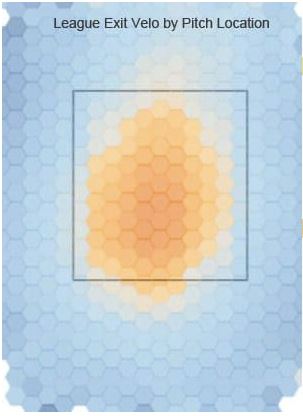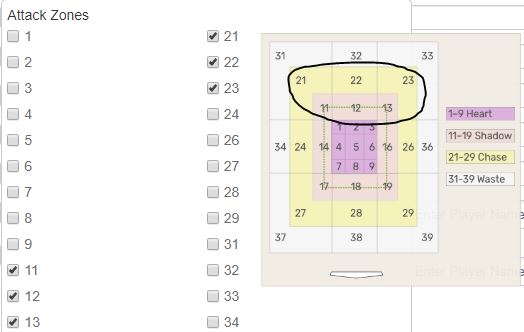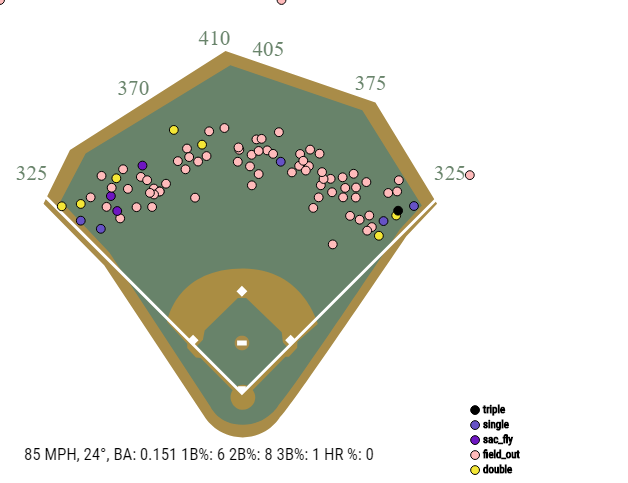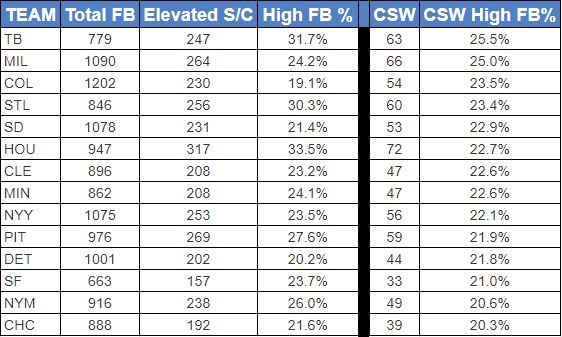I am a big fan of keeping the four-seam fastball elevated, not only for the purposes of creating better pitch tunnels but also for its ability to create effective velocity on the respective handedness of the batter. Though this high fastball philosophy is dependent on an efficient spin rate, meaning it can benefit a high-spin pitcher as the fastball stays elevated longer (see: Magnus effect) or a pitcher without the “recommended” spin rate who understands his four-seam movement well enough to prevent it from dropping too deep into the heart of the zone.
With swing paths changing thanks to the impact of the Statcast era (launch angle/exit velocity), the effectiveness of the high fastball has become more profound. To elaborate, a high-spin fastball high in the zone (or, any location for that matter) will give the appearance of “rise” only because the pitch (because of the spin) drops much slower than average spin. High fastballs can also be a little dangerous. A hitter who can create an upward swing on contact is already ahead of the game as he’s got that few extra inches needed to help drive the ball up over the outfielders or even the fence.
A pitcher with high spin will have a more “flat” trajectory (so long as the velocity coincides) under the same circumstances, which in turn will either cause the hitter to swing under it enough to create a pop-up/fly ball or miss the bat entirely. There are other schools of thought on fastball location, each with their own merit, but the high fastball has proven to have the larger benefit.
This zone heatmap created by Andrew Perpetua shows league-average exit velocity, with the darkest blue being the lowest and the deepest orange being the highest.

Know that this encompasses all pitches, not just fastballs, but you can see the value of keeping the pitch elevated.
Going forward, the zone I’m going to focusing on is what Baseball Savant defines as both the shadow and chase zones (elevated S/C). The image below will detail what I’m talking about specifically (zones 11-13, 21-23).

Elevated Shadow/Chase Zone
From 2016 through 2018, 21.7 % of four-seam fastballs were located in the elevated S/C. The three-year cumulative batting average is .177 with a .286 wOBA (.281 xwOBA). Keep this with you for a moment.
Of all elevated S/C four-seamers, the total called strikes plus whiffs (CSW) ratio is 19.5%. Using this new statistic to gauge effectiveness is tough to apply because the accepted CSW quality is scaled to all pitches from a pitcher’s outing. We can, however, attempt to gain context to its effectiveness by looking at overall CSW rate to all other fastball locations in both the chase and shadow zone. CSW rate for all other fastball locations in the nonelevated chase zone comes out to 30.5%. That’s a significant difference from the elevated S/C. But on the flip side, batting average is well over 100 points higher and wOBA increased nearly as much (.364 xwOBA) in nonelevated S/C zones. Getting strikes are important but limiting hitters’ damage on contact is significantly more valuable.
So if hitters aren’t whiffing or taking high fastballs for strikes as much, what is really happening up there? Almost half of all contact in elevated S/C zone is popup/fly balls along with 28% being ground balls (a 1.72 FB/GB ratio). We can safely assume that hitters are getting under the pitch, perhaps because of the previously mentioned “launch-angle” type swing.
Speaking of launch angle, we see an average LA of 23.6-degrees on high fastballs. Coupled with an average exit velocity of 85.2 mph, the graphic below shows the expected results are pretty close to what the actual batting average is on the elevated S/C zone.

Metrics for 85.2 MPH EV/ 23.6-degree LA
So now that I’ve made a case stronger for high four-seam fastballs, let’s take a look at what teams are doing it the most and if there have been any early benefits (please note that all data is as of April 18).
I took all four-seam fastballs thrown by each team so far in 2019 and then broke them down further to get the ratio of elevated S/C fastballs.

The top 15 highest-ratioed elevated fastballs contain some of the early season’s productive teams. The Houston Astros have the largest separation from their preceding team in this group.
Let’s take it one step further and see what teams draw the highest rate of CSW on the elevated four-seam.

We see some familiar teams showing up in this chart, and in terms of outperforming the rest, The New York Mets, Pittsburgh Pirates, Houston Astros, St. Louis Cardinals, and the Tampa Bay Rays stand above.
All five teams have above average elevated S/C fastballs and CSW-rate. For posterity, the league average high-fastball rate is 24.5% and for CSW, it’s 20%. Let’s look into these teams a little to see what, if any, benefit they are getting from attacking hitters high in the zone with the four-seam fastball.
I’ll be using Fangraphs (and their new + Stats) as well as Baseball Reference’s detailed standings for further information.
The Mets are currently 10-8 (8-10 pythWL) with a -10 run differential. The offense is sixth overall in RS/G (5.7) but are worst in the league when it comes to runs allowed (6.28). The Mets are eighth overall in K%+ (107) but are in the bottom 10 in BB%+ (107). While the Mets currently have the biggest ERA-FIP disparity, it should be known that it’s based on their bottom-five team ERA of 5.65.
The Pirates are fifth in the league with a .625 winning percentage (9-7 pythWL) and have a run differential of +5. Only about half a run (in favor of the offense) separates their average scoring environments. The pitching staff is top five in both strikeout (24.6%) and lowest in walk rate (7.2%). The same goes for their K/BB+ rate of 139, which is good for third-best in baseball. However, the staff may be due for some regression as their ERA/FIP spread is the second worst, favoring their FIP by .79. However, the team ERA of 2.63 is very impressive, and even with the expectation of increase, they’d still be top 10 in that category.
Another product of the National League Central, the Cardinals appear to be using the high fastball to some success as well. The team is around the middle of the pack for win percentage (.556) with the same pythWL as their actual record. In terms of ERA, the team is middle of the road as well, except they are much worse in terms of FIP and have the largest difference in baseball with almost a full run higher FIP than ERA. In fact, most every aforementioned metric sees the Cardinals dancing around the median. An exception is the team BB%+ rate of 124, which is good for third overall.
The Astros are baseball’s hottest team right now and also boast one of the best coaches in all of baseball, Brent Strom. A colleague of effective velocity pioneer Perry Husband, Strom understands the value of the high fastball. The Astros average the second-lowest runs allowed per game, are third in ERA (3.00) with just a .15 FIP differential, and lead the league in K/BB+ (163). Houston’s pitching staff is firing on all cylinders right now.
Last but not least, we have the Rays. Tampa Bay is throwing the high fastball at the third-highest rate and is tops in CSW on the pitch. They are nipping at the heels of the Astros in K/BB+ (160) and have the best team ERA by a sizeable margin (2.33). The team pitching performance during the first month can be backed by their 2.70 FIP, which is just .37 points higher than their ERA. The Rays lead the league in strikeout (29.7%) and are by far the most efficient at preventing the home run (0.72 HR/9).
Now that we have some performance context in relation to throwing the four-seam to the elevated S/C, we now need to look at how that compares with all other four-seam fastballs thrown.

So it seems that, with a couple of exceptions, the elevated four-seam fastball has been a big help to each team’s pitching performance, except for the Cardinals, who seem to find better success elsewhere in the zone. There are myriad reasons why that could be the case and elaborating on that context could be an article in and of itself. What’s even more vexing is the fact that the Cardinals’ fastballs are rated eighth overall in terms of Pitch Info pitch value while all other pitches are considered below average.
The only other anomaly here is the Rays’ four-seamers have a 1.2 mph lower effective velocity in other locations. Its not too disconcerting considering that both wOBAs are essentially the same but the nonelevated S/C fastballs have a much lower xwOBA.
What this can tell us is that teams like the Mets, Pirates, and Astros are being supported by effective use of the elevated fastball and would probably see some level of improvement if they start incorporating it more. Obviously, there are other things to consider but on the surface, we see its benefit even if it’s not directly correlating to early-season success.
We also must keep in mind that the elevated four-seam fastballs are at a much smaller sample than the rest of the pitches (and locations). Yet, it bears some significance because (four-seam) fastballs are thrown more than any other pitch and its effect on the rest of the pitcher’s repertoire is significant in that you need that pitch to work above all else. It will be interesting to see how this fluctuates as the season goes on and what, if any, relationship the elevated fastball will have on team performance.
(Photo by Mark Goldman/Icon Sportswire)

Great article, Mike! I love the exit velocity chart you included. It shows why placing pitches at the bottom of the strike zone isn’t necessarily optimal since hitters can still get to them pretty well.
Would you argue that a team like the Rockies, who already seem to have a collection of pitchers that produce good results on the high fastball, should aim to do it more? Conversely, if a team has a bad CSW% on High Fastballs, then perhaps they shouldn’t necessarily force their pitchers into it.
Thanks Nick!
The Rockies actually use the high four-seam the second least at 19.1% (AZ is 18.6%).
1202 total four-seamers, 230 are elevated with 54 CSW. That rate of 23.5% is third-best in baseball (as of the 19th).
That’s tough to say about the low CSW rate. The bottom five teams are the White Sox, Rangers, Royals, Dodgers, and Mariners. I would think that if they are producing a low EV and/or (x)wOBA high in the zone, they can get away throwing the four-seam high in spite of the low CSW rate.